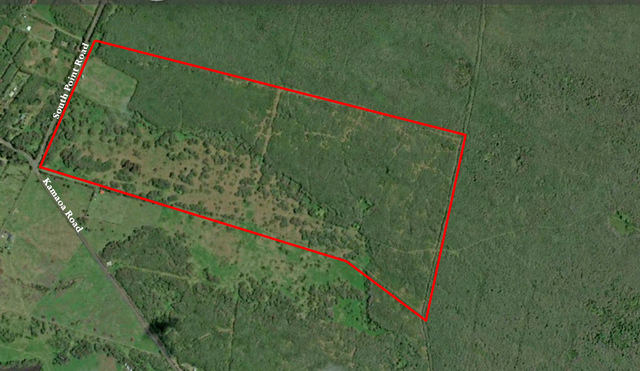A New Mexico-based nonprofit wants to bring a thriving forest to 190 acres in the South Point area of Ka‘u.
The Black Rhinoceros Foundation’s goal is to establish a mixed-species forest on the agricultural property, maintaining a sustainable yield of valuable forest products, while preserving the cultural sites within, and the health and function of the Puueo Ahupuaa and South Point Watershed, according to a draft environmental assessment issued today.
It plans to plant primarily indigenous and endemic Native Hawaiian trees at the site. Approximately 20 percent of the plantings will be introduced hardwood timber trees that will increase the planting diversity, provide wildlife habitat and, after a number of years, the ability to selectively harvest those trees to support the effort. The trees will also provide a windbreak for establishing plants.
“The thrust is to restore that native habitat with some diversity in there,” said John Pipan, with TerrAqua Environmental Consulting based in Honokaa. The nonprofit foundation expects a finding of no significant impact for the project.
The parcel, located near the intersection of South Point and Kamaoa roads, comprises gentle sloping former ranchlands covered with “noxious and invasive” species like Christmas berry, haole koa, lantana, and common guava, which will be controlled and replaced with more “desirable and productive vegetation.”
The primary species that will be established there include iliahi (Hawaiian sandalwood) and koaia (dwarf koa). They will be complemented by other native, Polynesian, and non-native and non-invasive species such as milo, sapote, cocobolo, granadillo, guanacaste, aweoweo, aalii, kolomona and pigeon pea. Plant materials will be sourced from three Big Island nurseries, and seeds for native plantings will be collected from sources as near to South Point as possible.
The project will also serve as a seed bank for the Hawaiian endemics, as well as a demonstration site for a viable and productive investment strategy for formerly forested agricultural lands.
“That’s huge,” Pipan said, referring to the seed bank. “That’s probably one of the hardest things I come cross when propagating these rare plants is finding good fresh viable seed. Just getting those initial plants is kind of gaining us a better foothold for future projects.”
The Black Rhinoceros Foundation Forest Stewardship Project is seeking a cost-share grant with the state’s Forest Stewardship Program. The grant will help fund the first 10 years of the $1 million project, which will be done in phases. The foundation will contribute more than $530,000 during the first decade.
The DLNR Division of Forestry and Wildlife-administered program provides technical and financial assistance to owners of nonindustrial private forest land that are interested in conservation, restoration, and/or timber production.
Statewide, there are 13 active projects covering 2,782 acres, four of which are getting underway.
“It’s wonderful to have private landowners interested in managing their forests and we can provide some technical guidance and some support to do it,” said Irene Sprecher, DOFAW cooperative resource management forester. “We’re looking to grow the program a little bit to get more folks interested in doing sustainable management.”
After 10 years, Pipan said costs will decline because much of the work will be maintenance as the trees continue to mature. Eventually, timber will be harvested, and the sandalwood trees alone are expected to result in net revenue, which could vary depending on the future price per metric ton. Pipan also noted the sandalwood trees could provide revenue prior to maturation and harvest.
“Whether or not the trees are harvested they have value,” he said. “It’s pretty exciting niche industry in sandalwood seed as a crop — not in terms of propagation for new trees — but they are edible and quite tasty. The idea is they are the ‘caviar of the Hawaiian forest.’”
The project could also provide a boost to the local economy in South Hawaii.
“It’s giving a lot of local businesses very needed income — myself included — and there’s lots of guys on the implementation side, on the planting and weeding and maintaining sides,” Pipan said. “It’s a big plus for a lot of people here.”
The foundation does not expect the project to negatively impact soil, water, flora and fauna, and cultural and archaeological resources. To the contrary, it may provide habitat for many bird species, as well as the endangered Hawaiian hoary bat, according to the draft EA.
Sidebar box on jump:
The public has 30 days to provide comment on the draft EA. Send comments to Consultant John Pipan, 44-317 Pua Olena St., Honokaa, HI 96727; and DLNR Division of Forestry and Wildlife, 1151 Punchbowl St. Room 325, Honolulu, HI 96813. View the document online at http://oeqc.doh.hawaii.gov/default.aspx and then click on the following folders: “EA_and_EIS_Online_Library,” “Hawaii” and “2010s.”






